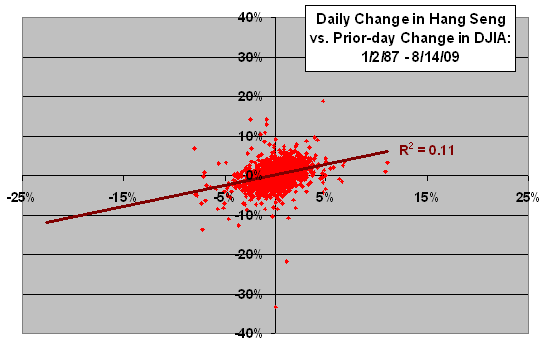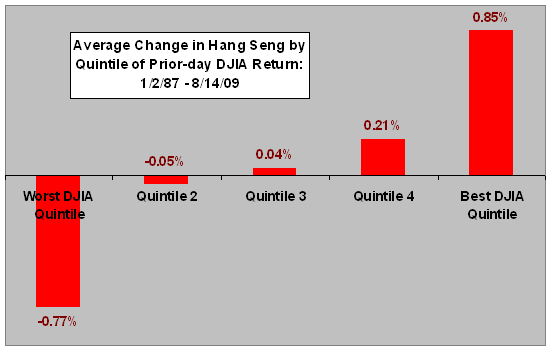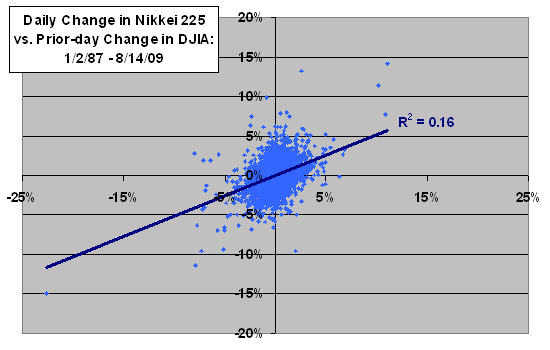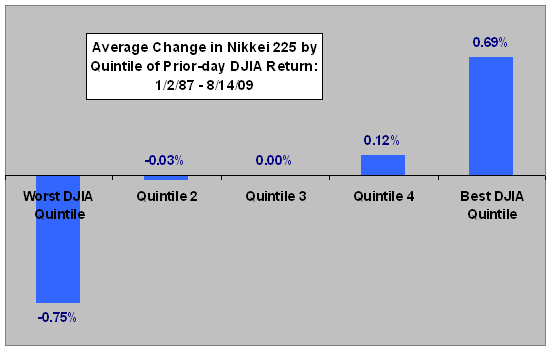A reader observed and asked: “In the last few weeks, there have been several times when the Dow Jones Industrial Average (DJIA) was down a lot, and Asian stock markets followed it down the next day. How reliably do Asian stock markets follow sharp drops in the U.S. stock market?” To investigate, we first examine the overall relationship between the U.S. stock market (represented, as suggested, by the DJIA) and Asian stock markets (Hang Seng and Nikkei 225). Then, we focus on what happens in Asian stock markets the day after sharp drops in the U.S. market. Using daily closing levels of the DJIA, the Hang Seng index and the Nikkei 225 index for 12/31/86-8/14/09 (roughly 5800 trading days), we find that:
The three stock markets under consideration have different operating schedules, with some multi-day closures. Since market-moving news other than movements of other global markets might occur when markets are closed, we exclude from analysis those trading days during which compared markets are not both open. We use calendar dates to define days.
First, we look at the relationship between DJIA and Hang Seng.
The following scatter plot relates the daily change in the Hang Seng and the prior-day change in DJIA over the entire sample period. The Pearson correlation between these two series is 0.34, indicating that the Hang Seng index follows DJIA to some degree. The R-squared statistic is 0.11, suggesting that DJIA behavior explains 11% of next-day Hang Seng behavior.
We repeat the analysis for the recent 1/3/00-8/14/09 subperiod, for which the Pearson correlation is 0.40, indicating that the leader-follower relationship between the two markets is consistent.
The relationship between same-calendar day changes in DJIA and Hang Seng is weaker, with Pearson correlation 0.19 and R-squared statistic just 0.04, supporting a view that the U.S. market provides a stronger lead for the Chinese market than vice versa. For the recent 1/3/00-8/14/09 subperiod, the Pearson correlation is also 0.19, again indicating consistency.
Do the tails of the return distributions dominate the relationship?

The next chart summarizes average daily Hang Seng return by sorted quintile (fifth) of prior-day DJIA returns over the entire sample period. For example, the fifth of days with the highest DJIA daily returns comprise the “Best DJIA Quintile.” While the chart shows systematic progression in average Hang Seng returns, the tail results are most dramatic. The standard deviations of daily Hang Seng returns are higher for the tails (2.0%-2.1%) than for the middle quintiles (1.4%-1.6%).
For the 1% (55) worst days for DJIA (plunges), the average daily Hang Seng return is -2.8% with standard deviation 3.7%. Plunges appear to be substantially contagious.
Are results similar for the Nikkei 225 index?

The next scatter plot relates the daily change in the Nikkei 225 and the prior-day change in DJIA over the entire sample period. The Pearson correlation between these two series is 0.40, indicating that the Nikkei 225 follows DJIA to some degree. The R-squared statistic is 0.16, suggesting that DJIA behavior explains 16% of next-day Nikkei 225 behavior (a little stronger than the relationship with the Hang Seng).
We repeat the analysis for the recent 1/3/00-8/14/09 subperiod, for which the Pearson correlation is 0.47, indicating that the leader-follower relationship between the two markets is consistent.
The relationship between same-calendar day changes in DJIA and Nikkei 225 is weaker, with Pearson correlation 0.11 and R-squared statistic just 0.01, supporting a view that the U.S. market provides a stronger lead for the Japanese market than vice versa. For the recent 1/3/00-8/14/09 subperiod, the Pearson correlation is 0.12, again indicating consistency.
Do the tails of the return distributions dominate the relationship?

The next chart summarizes average daily Nikkei 225 return by sorted quintile of prior-day DJIA returns over the entire sample period. While the chart shows systematic progression in average Nikkei 225 returns, the tail results are again most dramatic. The standard deviations of daily Nikkei 225 returns are higher for the tails (1.7%-1.8%) than for the middle quintiles (1.3%).
For the 1% (54) worst days for DJIA, the average daily Nikkei 225 return is -2.9%, with standard deviation 3.4%. Plunges again appear to be substantially contagious.
Are the preceding results exploitable?

There are obstacles to exploiting the above results:
The principal obstacle to exploiting market contagion is that follower markets tend to gap at the open in recognition of leader market moves. For example, as reported above, the average close-to-close daily Hang Seng return is -2.8% after the DJIA’s 55 worst days during the sample period. However, if we calculate this average return based on open-to-close rather than close-to-close levels of the Hang Seng (eliminating the overnight gap), the average daily return of the Hang Seng drops to -0.2%. On average, over 90% of the contagion is lost to overnight/weekend gaps.
Also, extreme moves in lead markets are rare (by definition), and they tend to cluster. For example, among these same 55 worst days for DJIA, there are none during 1992-1996 or 2004-2006. In contrast, there are 18 in the last four months of 2008. It is difficult to manage investment capital for such sporadic opportunities.
In summary, Asian stock markets do to some degree follow the U.S. market, including its sharp drops. However, U.S. market plunges are rare and clustered, the Asian market responses to these plunges are noisy, and overnight/weekend gaps on Asian markets substantially absorb plunge contagion.